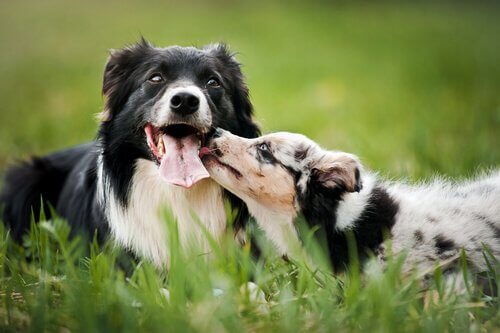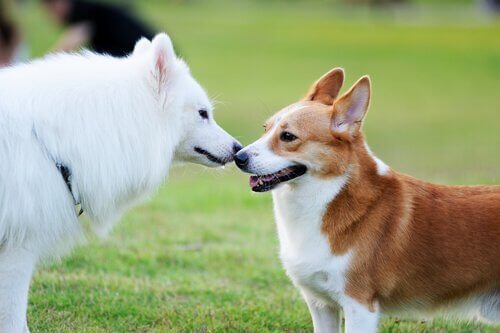Why Do Dogs Sniff each Other?


Written and verified by the lawyer Francisco María García
As you may know, smell is the most developed sense in dogs. When you see dogs sniffing each other, they are getting information about each other. They can find out from what they eat to their gender and even their emotional state. So, why do dogs sniff each other?
Dogs sniff each other to receive chemical messages
It is kind of like exchanging information through chemistry. In fact, it’s one of the many examples of chemical communication in the animal kingdom.
When dogs sniff each other, they activate an auxiliary olfactory system called Jacobson’s organ, or vomeronasal organ. This organ has a lot of capacity for chemical communication. Its nerves communicate directly with the brain.
Where the information comes from

Dogs receive a lot of information from sniffing. But where does it come from? On each side of our pet’s anus, there are two pockets called anal sacs. These excrete the chemicals that the dogs use to obtain information.
The apocrine sweat gland is the main gland responsible for transferring data when two dogs sniff each other. The sebaceous gland also plays an important role in this process.
In addition, when a dog grows, the anal sacs can cause problems. Sometimes fecal matter enters the glands, which can be annoying and even painful for the dog. If you see an animal dragging his anus on the floor, or trying to look at his rear end, you need to take him to the vet to have the glands cleaned.
It’s important to know that when dogs sniff anal sac secretions from others of their kind, they obtain very accurate information. However, we must take into account the fact that genetics, diet, and the immune system produce chemical changes that modify the odor.
On walks and while socializing
When you take your dog for a walk and he meets another dog, the following routine begins. They approach each other cautiously, move their tails or act alert, and then they each sniff each other’s rear ends right away. For those who have never had a dog, this behavior probably seems extremely odd.
However, it’s completely normal for dogs to sniff each other. You should never scold your pet for doing so. Instead, try to understand why they do it.
Even though it might bother you a little, it’s good to let your pet sniff other dogs for a few seconds so that he can develop his sense of chemical communication.
Sense of smell and memory
Since they are born blind and deaf, puppies use their sense of smell early on. Among other things, they use it to find their mother’s nipples in order to feed.
When they grow up and become adults, dogs have between 150 and 300 million olfactory cells. If we compare this to the 5 million cells that humans have, there is a huge difference.
Olfactory memory
In addition to having a well-developed sense of smell, dogs also have a very effective olfactory memory. They are able to remember the smells of other dogs, even if they haven’t seen them for years.
To give you an idea of olfactory distance, dogs can smell things in an area of 25 inches2, while for humans the area is only 2 inches2. As you know, your pets will always use smells to recognize and remember both you and other animals.
The sociability of each dog

The amount of information exchanged depends on the sociability of each dog, and whether they will allow themselves to be sniffed. The more sociable dogs raise their tails to facilitate sniffing, while the less sociable ones will keep their tails down and leave introductions for another time.
Some dogs are born without tails or have had their tails docked, and can’t communicate or be introduced. In some cases, disputes or arguments arise between them.
As you may know, smell is the most developed sense in dogs. When you see dogs sniffing each other, they are getting information about each other. They can find out from what they eat to their gender and even their emotional state. So, why do dogs sniff each other?
Dogs sniff each other to receive chemical messages
It is kind of like exchanging information through chemistry. In fact, it’s one of the many examples of chemical communication in the animal kingdom.
When dogs sniff each other, they activate an auxiliary olfactory system called Jacobson’s organ, or vomeronasal organ. This organ has a lot of capacity for chemical communication. Its nerves communicate directly with the brain.
Where the information comes from

Dogs receive a lot of information from sniffing. But where does it come from? On each side of our pet’s anus, there are two pockets called anal sacs. These excrete the chemicals that the dogs use to obtain information.
The apocrine sweat gland is the main gland responsible for transferring data when two dogs sniff each other. The sebaceous gland also plays an important role in this process.
In addition, when a dog grows, the anal sacs can cause problems. Sometimes fecal matter enters the glands, which can be annoying and even painful for the dog. If you see an animal dragging his anus on the floor, or trying to look at his rear end, you need to take him to the vet to have the glands cleaned.
It’s important to know that when dogs sniff anal sac secretions from others of their kind, they obtain very accurate information. However, we must take into account the fact that genetics, diet, and the immune system produce chemical changes that modify the odor.
On walks and while socializing
When you take your dog for a walk and he meets another dog, the following routine begins. They approach each other cautiously, move their tails or act alert, and then they each sniff each other’s rear ends right away. For those who have never had a dog, this behavior probably seems extremely odd.
However, it’s completely normal for dogs to sniff each other. You should never scold your pet for doing so. Instead, try to understand why they do it.
Even though it might bother you a little, it’s good to let your pet sniff other dogs for a few seconds so that he can develop his sense of chemical communication.
Sense of smell and memory
Since they are born blind and deaf, puppies use their sense of smell early on. Among other things, they use it to find their mother’s nipples in order to feed.
When they grow up and become adults, dogs have between 150 and 300 million olfactory cells. If we compare this to the 5 million cells that humans have, there is a huge difference.
Olfactory memory
In addition to having a well-developed sense of smell, dogs also have a very effective olfactory memory. They are able to remember the smells of other dogs, even if they haven’t seen them for years.
To give you an idea of olfactory distance, dogs can smell things in an area of 25 inches2, while for humans the area is only 2 inches2. As you know, your pets will always use smells to recognize and remember both you and other animals.
The sociability of each dog

The amount of information exchanged depends on the sociability of each dog, and whether they will allow themselves to be sniffed. The more sociable dogs raise their tails to facilitate sniffing, while the less sociable ones will keep their tails down and leave introductions for another time.
Some dogs are born without tails or have had their tails docked, and can’t communicate or be introduced. In some cases, disputes or arguments arise between them.
This text is provided for informational purposes only and does not replace consultation with a professional. If in doubt, consult your specialist.








